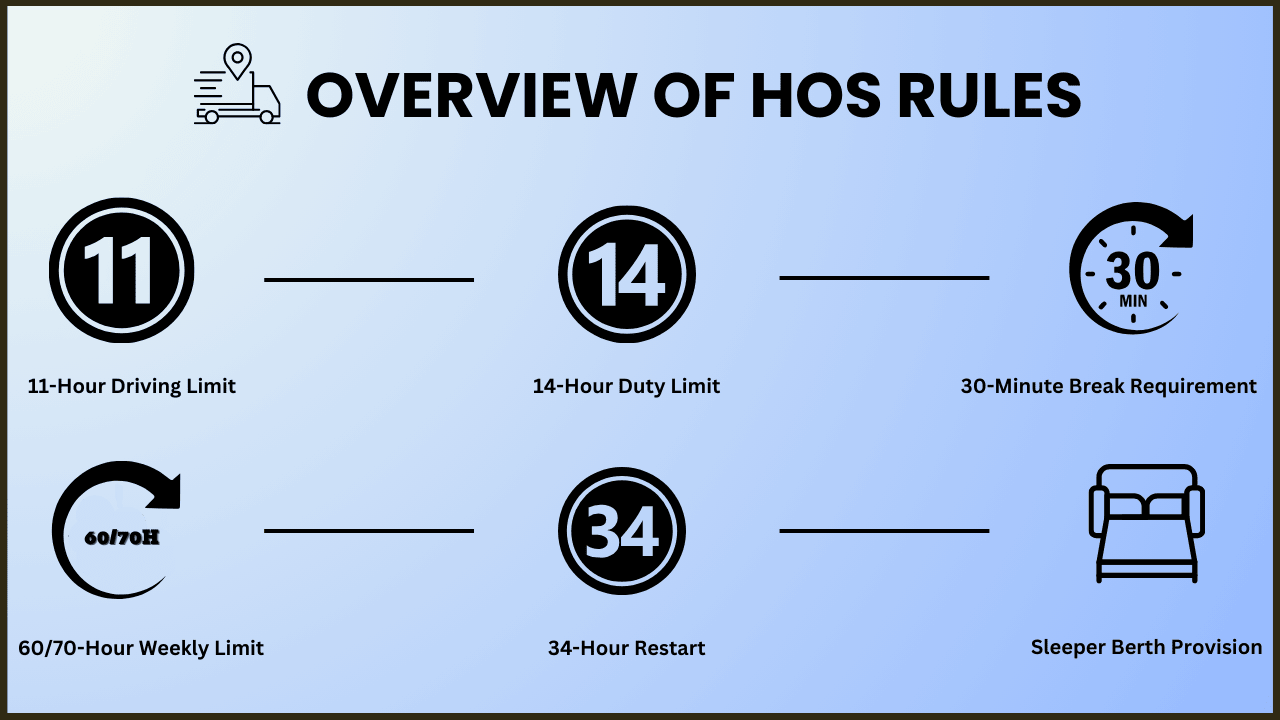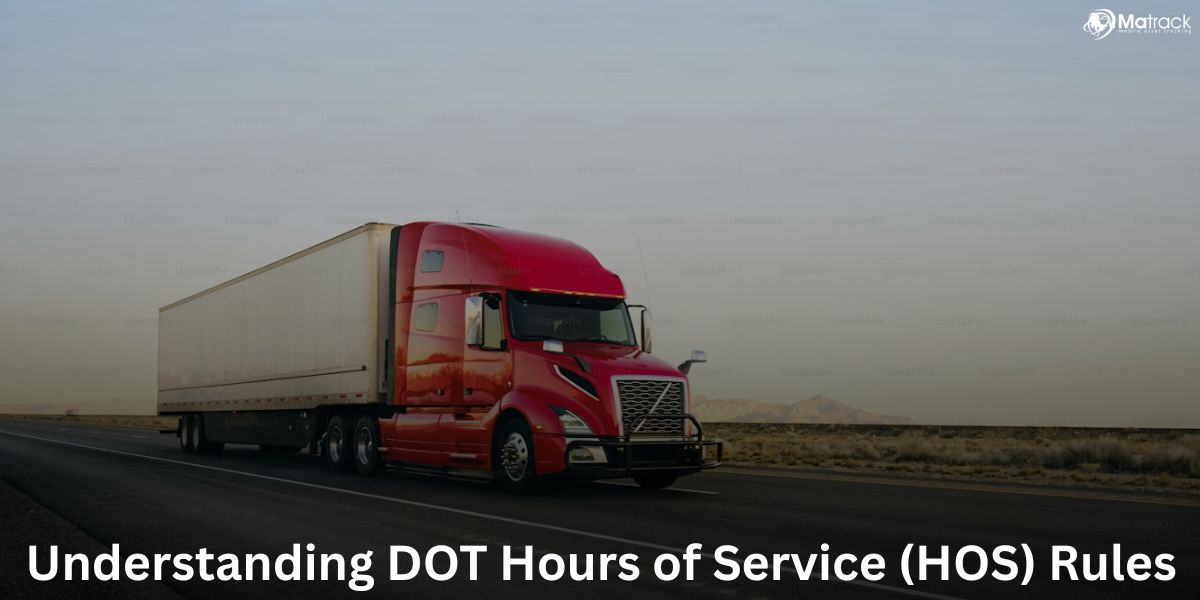Key Takeaways
- DOT HOS rules limit driving hours and require rest to prevent fatigue and improve road safety.
- These rules apply to drivers of vehicles over 10,001 pounds, carrying passengers, or transporting hazardous materials.
- Compliance avoids fines, improves safety scores, and ensures safe working conditions for drivers.
- Tools like ELDs and proper planning help drivers follow the rules and manage their schedules effectively.
What Are the DOT Hours of Service (HOS) Rules?
The DOT Hours of Service (HOS) rules, created by the Federal Motor Carrier Safety Administration (FMCSA), set limits on how long truck drivers can drive and work to prevent fatigue and improve road safety. These rules also include mandatory rest periods to ensure drivers stay alert and well-rested.
When do the hours of service regulations apply?
The Hours of Service (HOS) rules apply to drivers in the United States who operate commercial motor vehicles (CMVs) that meet specific conditions. These rules help keep roads safe and prevent driver fatigue. HOS applies in these situations:
Vehicle Weight
Vehicle weight determines if HOS regulations apply. These rules cover any vehicle with a gross weight rating (GVWR) or gross combination weight rating (GCWR) over 10,001 pounds.
Hazardous Materials Transport
Hazardous materials transport must follow HOS regulations when carrying placarded hazardous materials classified by DOT, such as flammable or toxic substances.
Passenger Transport
Passenger transport is regulated for vehicles designed to carry:
- 9 or more passengers, including the driver, if operated for payment.
- 16 or more passengers, including the driver, whether or not payment is involved.
Interstate Commerce
Interstate commerce requires HOS compliance for operations crossing state lines or transporting goods and passengers as part of interstate trade.
Intrastate Commerce
Intrastate commerce may be subject to state-specific HOS rules, though many states align with federal standards. Always confirm local requirements when operating within one state.
Purpose of DOT HOS
The primary objective of the HOS rules set by the FMCSA is to enhance the safety of truck drivers on the road. There are mandatory breaks between driving shifts to prevent accidents caused by fatigue. Based on DOT estimates, fatigue among truck drivers contributes to over 8,000 truck-related incidents annually.
Furthermore, the National Highway Traffic Safety Administration (NHTSA) reports that each year, around two million people get injured in motor accidents, with approximately 65% of these accidents happening during extended trips. Compliance with HOS rules is instrumental in mitigating these alarming statistics.
Truck drivers rely on ELDs to adhere to HOS rules. These devices, installed in trucks, automatically record driver and fleet operations data, ensuring drivers take necessary rests for safety reasons.
Do hours of service rules apply to me?
Generally, all carriers and commercial motor vehicle (CMV) drivers must adhere to the FMCSA and DOT’s HOS rules. This requirement applies to both property-carrying and passenger-carrying drivers. US drivers, as well as drivers from neighboring countries of Canada and Mexico, must also follow these rules.

If any of the following are true, the rules will apply:
- The vehicle’s weight is more than 10,000 pounds.
- The vehicle can carry at least 16 people.
- The vehicle can carry hazardous material requiring a placard.
- The vehicle can carry 9 or more passengers, including the driver, for compensation.
Familiarity with the FMCSA rules is crucial due to the significant concern and risk posed by driver fatigue, affecting the drivers and the public. The mandated breaks, as outlined by the HOS DOT, are essential measures in preventing accidents effectively.
DOT Hours of service (HOS) rules overview

11-Hour Driving Limit
11-Hour Driving Limit means driving up to 11 hours after taking 10 hours off duty. This rule ensures you’re well-rested before driving.
Example: If you start driving at 7 a.m. after resting, you must stop driving by 6 p.m., including any breaks.
14-Hour Duty Limit
14-hour Duty Limit means you cannot work more than 14 hours after starting your day, even if you don’t drive the full 11 hours. This includes driving, loading, unloading, and breaks.
Example: If you start at 8 a.m., your workday ends at 10 p.m., no matter how long you drive.
30-Minute Break Requirement
30-Minute Break Requirement says you must take a 30-minute break after driving for 8 hours straight. This break can be off-duty, in the sleeper berth, or on-duty not driving.
Example: If you start driving at 6 a.m., you must take a 30-minute break by 2 p.m. if driving continuously.
60/70-Hour Weekly Limit
60/70-Hour Weekly Limit means you can’t drive more than 60 hours in 7 days or 70 hours in 8 days, depending on your company’s schedule.
Example: If you work 10 hours daily, you’ll reach the 60-hour limit after six days.
34-Hour Restart
34-Hour Restart lets you reset your weekly driving hours by taking 34 hours off duty. After that, you can start fresh for a new 7- or 8-day week.
Example: If you finish your week on Saturday night, taking Sunday and Monday off lets you start driving again on Tuesday with a reset clock.
Sleeper Berth Provision
Sleeper Berth Provision lets you split your rest time. You need to take 8 hours in the sleeper berth and an additional 2 hours off-duty or in the berth. This time doesn’t count against your 14-hour work limit.
Example: You can rest 8 hours in the sleeper berth, take a 2-hour break, and continue driving within legal hours.
HOS Exemptions and Exceptions
The DOT Hours of Service (HOS) rules include specific exemptions and exceptions designed to provide flexibility in certain situations. Here’s a breakdown:
30-Minute Break Exception
Drivers are not required to take a 30-minute break if they have a 30-minute non-driving period, such as on-duty time not spent driving.
16-Hour Short-Haul Exception
Drivers may extend their workday to 16 hours once every 6 days if:
- They start and end their shift at the same location.
- They finish their shift within 16 hours after taking 10 consecutive hours off duty.
- They haven’t already reset their week with a 34-hour restart.
150 Air-Mile Exemption
Short-haul drivers are exempt from keeping detailed logs if they meet these criteria:
- Operate within 150 air miles of the starting location.
- Start and finish the day at the same location.
- Complete their shift within 14 hours and take 10 hours off duty before the next day.
150 Air-Mile Non-CDL Exemption
Non-CDL drivers qualify for this exemption if they:
- Operate within 150 air miles of their starting point.
- Start and end at the same location.
- Work no more than 14 hours per day for five consecutive days or avoid consecutive 16-hour days.
Also see: DOT Requirements And Regulations For CDL Truck Drivers.
Adverse Driving Conditions Exemption
Drivers can extend their driving and duty limits by 2 hours when faced with unexpected bad weather or road conditions, provided the situation could not have been predicted when the trip began. Read more about Adverse Driving Conditions Exception.
Emergency Conditions
HOS rules are temporarily suspended during declared emergencies for drivers directly involved in relief efforts, such as transporting essential goods or providing aid to affected areas.
Practical Tips for Managing HOS Compliance
Electronic Logging Devices (ELDs)
Electronic Logging Devices make tracking HOS simple and accurate. They automatically record driving hours, rest breaks, and on-duty time, reducing errors and ensuring compliance.
Plan Your Route Strategically
Carefully plan your routes to avoid delays caused by traffic, weather, or construction. Use reliable tools and apps to optimize your driving schedule and save time.
Stick to a Consistent Sleep Schedule
Following a consistent sleep schedule is key to managing fatigue and staying alert. Aim to rest simultaneously daily to keep your body in a steady rhythm.
Take Breaks Wisely
Use your 30-minute breaks for meals, light exercise, or relaxation. This helps you stay focused, energized, and better prepared for long drives.
Know Your Limits
Always keep track of your driving and work hours to avoid accidental violations. Whether manually or with tools, staying aware of your limits ensures compliance.
Communicate with Dispatchers
Stay in touch with dispatchers if you face delays or other challenges. Good communication helps adjust schedules and prevents violations of HOS rules.
Why HOS Compliance Matters
HOS compliance is essential to avoid serious consequences for drivers and trucking companies.
Fines for HOS violations can range from $1,000 to $16,000, depending on the severity of the violation. Non-compliance can also result in a driver being taken off duty immediately, causing work disruptions and lost income.
HOS violations negatively affect a company’s CSA (Compliance, Safety, Accountability) score. A poor CSA score can lead to more inspections, stricter scrutiny, and harm to the company’s reputation.
Also see: A Comprehensive Guide To ELD Violations and Fines
Common Mistakes to Avoid
Pushing the Limits
Driving right up to your maximum hours can cause problems. Always plan extra time for delays like traffic or bad weather to stay within the rules.
Skipping Breaks
Not taking the required 30-minute break can make you tired and lead to violations. Always take your break on time to avoid issues.
Incorrect ELD Usage
Forgetting to log off-duty time or other mistakes on your ELD can cause violations. Make sure your entries are accurate and up to date.
Misinterpreting Adverse Conditions
Only use the adverse driving conditions exemption for true, unexpected issues like bad weather or road closures. Misusing it can lead to non-compliance.
Conclusion
Following DOT Hours of Service (HOS) rules keeps drivers safe and helps prevent accidents caused by fatigue. These rules also ensure drivers have fair working conditions.
Staying compliant avoids fines and protects a company’s safety record. Using tools like ELDs and planning ahead helps drivers stay productive and within the rules.
Also see: Everything You Need to Know About Hours of Service Rules in Canada



